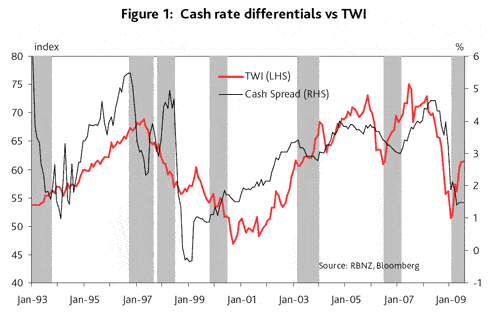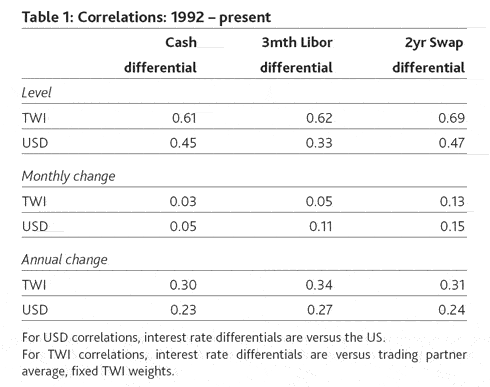Cutting OCR further may lift NZ$, not lower it, Westpac economists say
10th Aug 09, 10:53am
by
Some export groups have been clamouring for a cut in the cash rate in the belief that it would result in a lower currency. In the most recent Official Cash Rate (OCR) Review the Reserve Bank gave some comfort to those hopes, intimating that the level of the exchange rate may put the economic recovery at risk and, if the currency were to stay elevated, lower interest rates may be the response. In this article, we take a look at the relationship between the OCR and the exchange rate. We caution that lowering the OCR may not reduce the exchange rate at all, and could in fact make New Zealand's structural imbalances worse, not better. Currency drivers There are numerous potential drivers of the exchange rate, including (but not restricted to): interest rate differentials; risk appetite; commodity prices; momentum; relative inflation, economic growth and productivity; migration; external balances; and market participants expectations of the future path of all of the above. Which interest rate differentials matter? Higher interest rates in NZ relative to those available overseas tend to lead to a higher currency, holding all else constant. This is the nub of the "˜carry trade'. Foreign investors are encouraged to park some of their funds in New Zealand if our yield is relatively high. However, those investors tend not to invest overnight. Historically, it is the two year interest rate differential "“ rather than the cash rate differential "“ that tends to drive their behaviour. There have been numerous episodes in NZ's recent history where the exchange rate and interest rate differentials (both OCR and 2 year) have moved in opposite directions. Figure 1 highlights a few particularly large divergences. There are two avenues where cutting (or raising) the cash rate may not lower (or raise) the currency: longer term interest rate differentials may move differently from the cash differential, and all else may not be constant.

For example, if global risk appetite changes dramatically (e.g., during the Asian crisis, the bursting of the tech bubble, the sub-prime crisis), then the currency will tend to drop almost regardless of where interest rates are set. Equally when appetite for risk is back on the table, commodity prices tend to rise (as is occurring now) and so too does the currency. In a similar vein, NZ's 2 year interest rate differential tends to move in advance of the cash differential as markets anticipate future monetary policy. Occasionally, the differentials can move in opposite directions if the markets take a different view to the central bank, which will ultimately be reconciled. Correlations The correlation between the level of interest rate differentials and the currency is high (refer Table 1) reflecting that they tend to move in a similar direction over a number of years, in tune with the broad economic cycle. However, the correlation of the monthly change in both is only very weakly positive. The correlation is weakest for the cash rate differential, and gets stronger as the interest term lengthens. The correlation on an annual basis is far stronger. But as highlighted in Figure 1, there are significant episodes where the correlations turn negative. Regardless, it is necessary to note that correlation does not mean causation. For example, if commodity prices (or migration, or economic activity etc) are stronger, the currency is likely to be headed higher. Inflation pressures are also likely to be rising, encouraging higher interest rates. Interest rates and the currency may be moving in the same direction, but not directly causing each other to do so. Equally, causation does not mean correlation. Interest rate differentials could be pushing the currency in a particular direction, but being swamped by movements in other variables.

The currency is where it is It is useful to keep in mind that the currency is always where it is for a reason. We struggle to say whether the NZ currency is either under or overvalued at present. On a trade weighted basis (TWI) the currency is currently 62.2. Its average since 1985 has been 60.8 (and 61.6 since 1995). It is very close to its average level even though NZ's terms of trade (pre the big August Fonterra auction) are 14% above their post-1995 average, and New Zealand's economy has come through the global downturn better than most. Against the AUD, the NZD is virtually bang on our estimate of fair value. If the global financial crisis entered a second phase, then the NZD would undoubtedly be sold aggressively. This in itself would be bad for exporters. The currency may well be telling us something. If the expected conditions that it is based on prove to be false, it will unwind of its own accord. Imbalances A big part of the desire for a lower currency is to correct New Zealand's structural imbalances (i.e., heavy reliance on foreigners' savings, and growth dominated by leveraged consumption at the expense of exports). However, currencies are two-way streets. Not every country in the world can simultaneously devalue their way to competitiveness. As we note above, NZ has come through this financial crisis in better shape than many. And the markets are currently judging that NZ's challenges are less than those of the US. On the imbalances issue, we have strong affinity with comments made by Dr Alan Bollard in his recent speech simply titled "Economic Recovery". We repeat some of those below: "Sustainable recovery, with rebalancing in demand and the economy's productive base, is mostly a microeconomic matter. This means households, firms, banks and investors making the right decisions about where to allocate land, labour, capital and funding. The Reserve Bank's role in this is essentially facilitative." "Our status as a deficit country with a particularly large net foreign liability position means that, more than for most other countries, our recovery depends on a sustained pickup in net exports." "A clear risk beyond near-term recovery is that households resume their "˜borrow and spend' habits before bringing their debt levels back to more prudent levels. A premature resumption of strong growth in household spending could be triggered, for example, by renewed moderate house price inflation. This needs to be avoided." "The onus on us is even greater to shift domestic savings behaviour in the right direction." Cashing in To us, lower interest rates would most likely exacerbate imbalances in the economy "“ not ameliorate them. New Zealand's current account deficit reflects a dearth of domestic saving, "˜excessive' housing investment, and a less than spectacular net export position. Lower interest rates would likely lower domestic savings, lift consumption, and raise investment (at least in the short term) and increase imports. The effect on exports is ambiguous. Given the low starting point for the OCR (2.5%) and the nature of the economic recovery unfolding (higher net migration, increased residential construction, higher house prices, and consequently a potentially reinvigorated consumer), we think lower interest rates would fuel those sources of economic growth and potentially lead to a higher "“ not lower "“ currency. To the extent that monetary policy can affect imbalances, it should focus on those aspects (i.e., domestic spending) that it can most influence. The lessons of 2003 are fresh in our mind.

We welcome your comments below. If you are not already registered, please register to comment.
Remember we welcome robust, respectful and insightful debate. We don't welcome abusive or defamatory comments and will de-register those repeatedly making such comments. Our current comment policy is here.